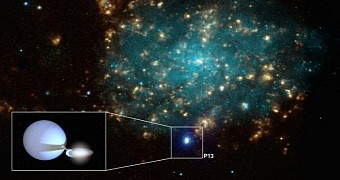Imagine 100 billion billion hot dogs piled up together. Done that? Good. Now imagine eating them all in one minute. It sounds like a sci-fi kind of scenario, right? Well, apparently, it's very much doable. Just as long as you have the appetite of a black hole.
Not to beat about the bush, it was this past October 8 that astronomers announced the discovery of a black hole that consumes the weight equivalent of 100 billion billion hot dogs each and every minute of its existence. Even weirder, this black hole isn't even big enough to explain its appetite.
A black hole with a mind-boggling appetite
Writing in the journal Nature, scientists with the International Center for Radio Astronomy Research in Australia explain that the black hole in question goes by the name of P13.
It sits at a distance of about 12 million light-years from our planet, on the outskirts of a galaxy known to the scientific community as NGC7793, the astronomers go on to detail.
When they first noticed this black hole, scientists were quite surprised by how luminous it appeared to be. They assumed that P13 was so much brighter than the majority of the black holes thus far documented because it was freakishly big.
“It was generally believed the maximum speed at which a black hole could swallow gas and produce light was tightly determined by its size,” researcher Dr. Roberto Soria said in a statement.
“So it made sense to assume that P13 was bigger than the ordinary, less bright black holes we see in our own galaxy, the Milky Way,” the Curtin University astronomer went on to explain.
However, once they got a closer look at this black hole, Dr. Roberto Soria and colleagues found that it was actually quite small. However, it was eating gas from a star located in its proximity at a rate 10 times greater than thought possible, given its size.
“As hotdog-eating legend Takeru Kobayashi famously showed us, size does not always matter in the world of competitive eating and even small black holes can sometimes eat gas at an exceptional rate,” Dr. Roberto Soria commented on this find.
Following this discovery, P13 was included in a group of rare black holes that scientists refer to as ultra-luminous X-ray sources. Such stars have such big appetites that they can eat an entire star in under 1 million years, which, on a cosmic scale, is a strikingly short period of time.
Describing the black hole and its donor star
As mentioned, this newly discovered black hole feasts on gas originating from a so-called donor star in its proximity. This star is said to weigh about as much as 20 Suns put together. By comparison, the black hole is less than 15 times the mass of the Sun.
Because of its appetite, P13 has come to be about 1 million times brighter than our Sun. Interestingly enough, researchers say that X-rays originating from near P13 illuminate the black hole donor star, causing one of its sides to forever appear brighter than the other.
The black hole and the star that has become its own, personal takeaway restaurant constantly circle each other. Astronomers with the International Center for Radio Astronomy Research estimate that it takes about 64 days for P13 and its donor star to go one around the other.

 14 DAY TRIAL //
14 DAY TRIAL //